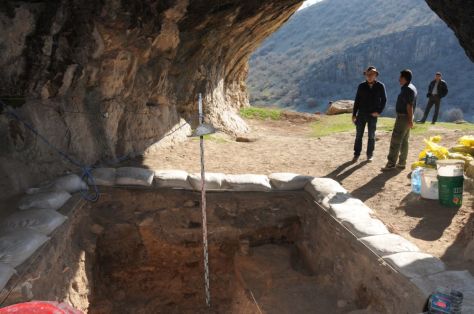NewsNext Previous
The IPHES Catalan research center and the Iranian RICHT Institute started a regular cooperation in the field of archaeology and human evolution
They will study the extinction of the last Neanderthals and the emergence of Modern humans and in the Central Zagros
The research collaboration involves also training for postgraduate students, fieldwork seasons, specific analyses of archaeological materials and researcher-exchange programs
The IPHES (Institut Català de Paleoecologia Humana i Evolució Social), a research center from Tarragona (Catalonia, Spain), and the RICHT (Iran’s Research Institute for Cultural Heritage and Tourism) have started a regular cooperation in the field of archaeology and human evolution.
Furthermore, this project will be the first step for studying the entire ensemble of Paleolithic sites of the Khorramabad Valley (Iran) using a regional multidisciplinary approach, in order to obtain a clear view of its position in the global Paleolithic context and subsequently to update the scientific literature of this significant region.
Previous archaeological campaigns
IPHES’ researchers have previously collaborated in the field archaeological campaigns of 2010- 2011 in the Khorramabad Valley Paleolithic sites. From this collaboration derived the funding by Fundación Atapuerca of a PhD for Behrouz Bazgir (an Iranian researcher) at IPHES. The first international publication provided relevant data on the Middle and Upper Paleolithic human presence in the area (Bazgir, B., Otte, M., Tumung, L., Ollé, A., Deo, S.G., Joglekar, P., López-García, J.M., Picin, A., Davoudi, D., Made, J.v.d., 2014. Test excavations and initial results at the Middle and Upper Paleolithic sites of Gilvaran, Kaldar, Ghamari Caves and Gar Arjene Rockshelter, Khorramabad Valley, western Iran. C.R. Palevol 13, 511–525).

From October 2014 to January 2015, Behrouz Bazgir from IPHES directed again a successful campaign in one of the Khorramabad Valley Paleolithic sites: Kaldar Cave. Eudald Carbonell (IPHES Researcher) and Andreu Ollé (IPHES Researcher) joined in January the Kaldar archaeological season and visited the most important Paleolithic sites in the Khorramabad Valley. Furthermore, Carbonell, Ollé and Bazgir delivered a public talk on the Khorramabad Palaeolithic Project at Lorestan Cultural Heritage, Handicraft and Tourism Organisation in the Khorramabad city.
Research agreements with Iranian authorities
The collaboration between IPHES and the Islamic Republic of Iran authorities has been formalized through a Memorandum of Understanding on Joint Research and Education Cooperation, signed on 28th of October 2014 with the Research Institute of Cultural Heritage and Tourism (RICHT) of the Islamic Republic of Iran. This Memorandum is based on five-years joint program to accomplish archaeological field projects on land (surveys, sounding, excavation, programs of rescue and material analysis on organic and inorganic remains) in order to train team members of the both parties (researchers and students) in the field of analytical and field techniques, providing the facilities and a conservative plan for objects and findings unearthed within archaeological excavations.
Ongoing research
From this framework, the archaeological materials recovered last winter from the Kaldar Cave are now temporarily deposited at IPHES and currently subjected to an interdisciplinary analysis approach from micro and macrofauna, archaeobotany and lithic technology experts. This intensive work is part of an ongoing PhD research program undertaken by Behrouz Bazgir. This research is framed in the International Doctorate in Quaternary and Prehistory (IDQP) at Universitat Rovira i Virgili (Tarragona, Catalonia, Spain).

The Catalan Institute of Human Palaeoecology and Social Evolution (IPHES) is based in Tarragona, Spain. It is a research center created in 2005 within the CERCA program of the Generalitat de Catalunya, and supported by different public institutions IPHES has a strong research profile in past Human-Environment interaction in a broad sense with a number of successful projects, grants and ongoing transdisciplinary collaborations with other institutes and universities around the world. IPHES research team is on the cutting edge of international scientific debates in diverse aspects of the fields of Prehistory and Human Evolution, and is widely regarded as a generator of knowledge across topics within these fields.
Since its foundation, the IPHES team has published 478 papers with impact factor (JCR), in a progression reflecting the growth of this young institution: 2014 (n=69), 2013 (n=81), 2012 (n=62), 2011, (n=53), 2010 (n= 44), 2009 (n=29), 2008 (n=28), 2007 (n=21), 2006 (n=19), 2005 (n= 6). The list includes Nature (4), Science (3), PNAS (10), Journal of Human Evolution, and Journal of Archaeological Science, among others.
RICHT is s an educational and research institution overseeing numerous associated museum complexes throughout Iran. It is administered and funded by the Government of Iran. It publishes and oversees the publication of many journals and books, and carries out projects in conjunction with foreign museums and academia.


